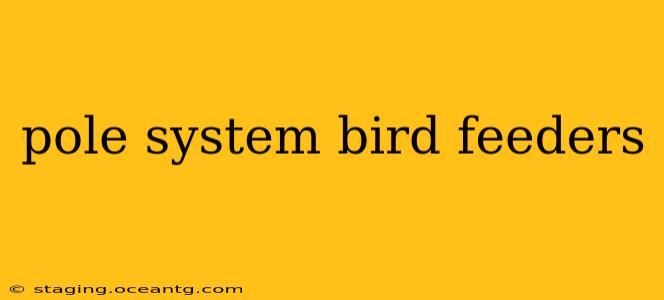Attracting birds to your backyard is a rewarding experience, offering a captivating glimpse into the natural world. A crucial element in successful bird feeding is choosing the right feeder, and pole-mounted systems offer numerous advantages. This guide delves into the world of pole system bird feeders, exploring their benefits, variations, and how to choose the perfect one for your needs.
Why Choose a Pole System Bird Feeder?
Pole-mounted bird feeders offer several key advantages over other feeder types:
- Height Advantage: Elevating feeders on poles keeps them away from ground predators like cats, raccoons, and squirrels, significantly improving the safety and feeding success of your feathered friends.
- Accessibility for Different Birds: Different bird species prefer different feeding heights. A pole system allows you to adjust the feeder's height to accommodate various species.
- Enhanced Visibility: Elevated feeders provide better viewing opportunities for you, allowing for closer observation of your avian visitors.
- Easier Cleaning and Maintenance: Pole-mounted feeders are often easier to access for cleaning and refilling, especially those with a removable feeder component.
- Aesthetic Appeal: A well-placed pole system can enhance the aesthetic appeal of your garden, creating a natural focal point.
What are the Different Types of Pole System Bird Feeders?
The world of pole-mounted bird feeders is diverse. Here are some popular types:
- Simple Pole Feeders: These consist of a basic pole with a single feeder attached. They are budget-friendly and easy to install but may offer less protection from predators than more sophisticated designs.
- Pole Systems with Multiple Feeders: These systems allow for mounting multiple feeders of different types, catering to a wider variety of bird species and their preferences for various food types (seeds, suet, nectar, etc.).
- Pole Systems with Predator Guards: These systems incorporate baffles or other features designed to prevent squirrels and other predators from climbing the pole to reach the feeder. These guards come in various designs, from simple cones to more complex cage-like structures.
- Ground-Based Pole Systems: Instead of directly mounting the feeder on a pole, the pole serves as a support structure for a hanging feeder suspended at a safe height above ground.
What Height Should My Pole Bird Feeder Be?
The ideal height for your pole bird feeder depends on several factors, including:
- Predation: Higher is generally better for deterring ground predators. Aim for at least 4-5 feet above the ground.
- Bird Species: Some birds prefer feeding at higher elevations while others are more comfortable at lower heights. Observe the birds in your area to determine their preferred feeding heights.
- Your Viewing Preference: Consider the height that provides the best viewing experience for you.
How Do I Protect My Pole Bird Feeder from Squirrels?
Squirrels are notorious for raiding bird feeders. Effective squirrel-proofing strategies for pole systems include:
- Squirrel Baffles: These are crucial. Install a baffle (or multiple baffles) several feet below the feeder to prevent squirrels from climbing the pole.
- Choose a Feeder with Squirrel-Resistant Design: Some feeders are designed with features that make them difficult for squirrels to access.
- Smooth Pole: Avoid using rough or textured poles, as these provide better grip for squirrels. Consider using a metal or smooth plastic pole.
- Strategic Pole Placement: Place your pole away from trees or other structures that squirrels could use to jump to the feeder.
What Kind of Pole Should I Use for My Bird Feeder?
The ideal pole material depends on durability, aesthetics, and cost considerations:
- Metal Poles: Sturdy and durable, offering good resistance to weather and pests.
- Wood Poles: Can be aesthetically pleasing but require more maintenance and may be susceptible to rot or insect damage.
- PVC Poles: A cost-effective option that is lightweight, durable, and resistant to weather.
By carefully considering these factors and choosing the appropriate pole system and feeder design, you can create a haven for your backyard birds, providing them with a safe and reliable food source while enjoying the pleasure of observing their vibrant presence. Remember, regular cleaning and maintenance are essential to keep your feeders healthy and your birds safe.
